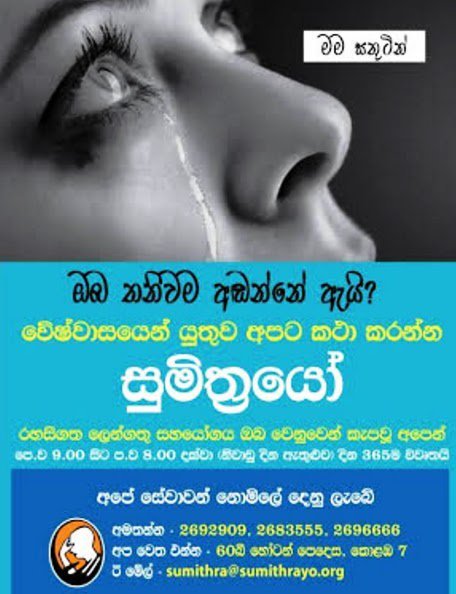Suicides Prevention WHO to help the world reach the target of reducing suicide rate
Suicide remains one of the leading causes of death worldwide, according to WHO’s latest estimates, published today in “Suicide worldwide in 2019”. Every year, more people die as a result of suicide than HIV, malaria or breast cancer ̶ or war and homicide. In 2019, more than 700 000 people died by suicide: one in every 100 deaths, prompting WHO to produce new guidance to help countries improve suicide prevention and care. Average of 08 persons die by suicide every day in Sri Lanka. If you or someone you love considering Suicide, Please Call below Suicides Prevention numbers.
SuicidePreventionSL Lifelines👇
☎️ Mental Health 1926 (toll FREE )
☎️ CCCline 1333 (toll FREE )
☎️ Sumithrayo- 0112696666
☎️ Shanthi Maargam- 0717639898
Sri Lanka had a suicide rate of 6.9/100,000 in 1950 which dramatically increased to 47/100,000 by 1995 to clock the highest in the world. But suicide prevention strategies implemented on recommendations by the Presidential Task Force of 1997 succeeded in bringing the rate down to 24/100,000 in 2004, 18/100,000 in 2014, and 16/100,000 in 2019. These included decriminalising the act of suicide (1998), a Life Skills Programme introduced by the Ministry of Education (1998), and banning the use of extremely toxic pesticides.
World Suicide Prevention Day falls September 10. September 10 World Suicide Prevention Day (WSPD) is an awareness day observed on 10 September every year since 2003, to provide worldwide commitment and action to prevent suicides.
“We cannot – and must not – ignore suicide,” said Dr Tedros Adhanom Ghebreyesus, Director-General of the World Health Organization. “Each one is a tragedy. Our attention to suicide prevention is even more important now, after many months living with the COVID-19 pandemic, with many of the risk factors for suicide ̶ job loss, financial stress and social isolation – still very much present. The new guidance that WHO is releasing today provides a clear path for stepping up suicide prevention efforts.”
LIVE LIFE
To support countries in their efforts, WHO is today releasing comprehensive guidance for implementing its LIVE LIFE approach to suicide prevention. The four strategies of this approach are:
- limiting access to the means of suicide, such as highly hazardous pesticides and firearms;
- educating the media on responsible reporting of suicide;
- fostering socio-emotional life skills in adolescents; and
- early identification, assessment, management and follow-up of anyone affected by suicidal thoughts and behaviour.
Banning of the most dangerous pesticides: a high-impact intervention
Given that pesticide poisoning is estimated to cause 20% of all suicides, and national bans of acutely toxic, highly hazardous pesticides have shown to be cost-effective, such bans are recommended by WHO. Other measures include restricting access to firearms, reducing the size of medication packages, and installing barriers at jump sites.
Responsible reporting by the media
The guide highlights the role the media plays in relation to suicide. Media reports of suicide can lead to a rise in suicide due to imitation (or copycat suicides) – especially if the report is about a celebrity or describes the method of suicide.
The new guide advises monitoring of the reporting of suicide and suggests that media counteract reports of suicide with stories of successful recovery from mental health challenges or suicidal thoughts. It also recommends working with social media companies to increase their awareness and improve their protocols for identifying and removing harmful content.
Support for adolescents
Adolescence (10-19 years of age) is a critical period for acquiring socio-emotional skills, particularly since half of mental health conditions appear before 14 years of age. The LIVE LIFE guidance encourages actions including mental health promotion and anti-bullying programmes, links to support services and clear protocols for people working in schools and universities when suicide risk is identified.
Early identification and follow-up of people at risk
Early identification, assessment, management and follow-up applies to people who have attempted suicide or are perceived to be at risk. A previous suicide attempt is one of the most important risk factors for a future suicide.
Health-care workers should be trained in early identification, assessment, management and follow-up. Survivors’ groups of people bereaved by suicide can complement support provided by health services. Crisis services should also be available to provide immediate support to individuals in acute distress.
The new guidance, which includes examples of suicide prevention interventions that have been implemented across the world, in countries such as Australia, Ghana, Guyana, India, Iraq, the Republic of Korea, Sweden and the USA, can be used by anyone who is in interested in implementing suicide prevention activities, whether at national or local level, and in the governmental and nongovernmental sectors alike.
“While a comprehensive national suicide prevention strategy should be the ultimate goal for all governments,” said Dr Alexandra Fleischmann, suicide prevention expert at the World Health Organization, “starting suicide prevention with LIVE LIFE interventions can save lives and prevent the heartbreak that follows for those left behind.”
Suicide, A major public health problem in Sri Lanka which demands our attention, but its prevention and control, unfortunately, are not an easy task. According to WHO, close to 800 000 people die globally by suicide every year, which is one person every 40 seconds. Furthermore, for each suicide, there are more than 20 suicide attempts.
Suicide is complicated and tragic, but it is often preventable. Knowing the warning signs for suicide and how to get help can help save lives.

How do I know that someone may be suicidal?
Being aware of warning signs can be potentially life-saving. Verbal markers are one way of identifying signs of suicidal ideation. They may sound something similar to the following:
“I feel like you and everyone would be so much better off without me.”
“I wish I was never born”
“I feel like I have no purpose”
“I feel numb”
Verbal markers can be either active (“I want to kill myself”) or passive (“I wouldn’t mind if I got hit by a bus…”) and it is important to look out for both types. Passive statements should be taken equally seriously.

How can someone’s behaviour indicate that they may be suicidal?
Sudden isolation from others
Researching methods to end one’s life on the internet
Increased agitation and mood swings
Reckless behaviour
Giving away what they own and writing last wills
Calling loved one’s/friends to say ‘good-bye’
Difficulties with sleep and appetite
Talking and writing about suicide
Loss of interest in daily and pleasurable activities
Loss of energy
Sudden positive mood after a period of being low
Purchase of materials intended for an suicide attempt
Additionally, if you or a loved one begins to feel irritable, hopeless, angry and anxious in addition to losing interest in activities that previously brought joy, these may also be other signs to be mindful of.

What can I do to help?
Take all talk of suicide seriously.
- Engage the person in a serious conversation – i. Connect in a personal way ii. Ask if they are experiencing a crisis in their lives iii. Are they feeling hopeless? iv. Have they withdrawn from daily activities?
i.e. Hey, I’ve noticed in the past few days that you seem rather low. I am concerned, and I am wondering if everything is okay…”
Ask about suicide using a caring approach
i.e. “I can see that you are going through a difficult time right now. Some people in your situation might feel like life is not worth living anymore. Have you felt this way?”
“Are you having thoughts about suicide?”
“Do you have thoughts about ending your life?”Explore risk by asking if they have a plan to attempt suicide and whether they have attempted suicide in the past.

Engage the person in a plan for safety
i. Do not leave the person alone
ii. Provide accessible contact information of crisis services
iii. Try to ensure that they do not use drugs or alcohol
iv. Be prepared to listen non-judgmentally
v. Do not promise confidentiality
Encourage the person to seek professional help as soon as possible.
Via WHO / Pulse. lk
For more information on mental health, see BetterHelp.

